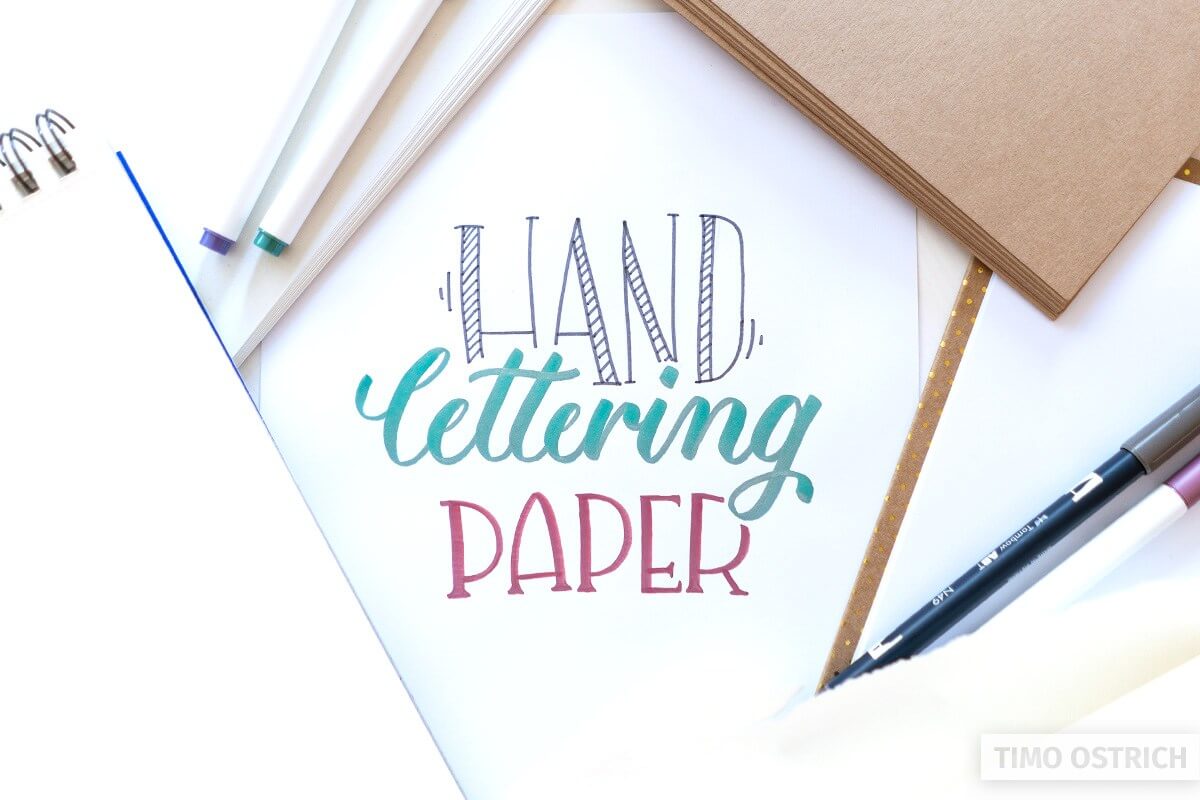When do you need which paper for lettering? Why do your pens break and how to save your tips?
It’s time to reveal the secret of the right lettering paper!
You should definitely take the time to read this article in order to really enjoy hand lettering!
Contents
Is the paper really important?
Before we plunge deeper into the matter, I would like to make a fundamental appeal.
The paper is just as important for your letterings as the pens!
I mention it again and again, but it is often forgotten. Everyone immediately thinks of pens with different properties for different purposes. But when it comes to the paper many people use what’s there at the moment.
To ensure that your handletters succeed in the future in the way you imagine, I have compiled the most important facts about handletting paper for you.
The pen determines the paper
For the basic lettering paper selection the tool used is decisive. In our case this is usually a pen (or several).
The properties of the pen determine the paper to be used.
This includes, above all, the quality of the pen tip, the colour application and the ink base. Additional factors (e.g. water) also influence the choice.
Below you will find the most important pen-paper combinations. They will help you to make your handlettering projects a success right away.
Which paper do I have to use?
Paper for brushpens
Probably the most important question: Which paper is suitable for brushpens?
Since the tips of brushpens are very sensitive, the choice of paper is particularly important here. If you use the wrong paper, your brushpens will break very quickly (they will fray).
When you take a closer look, you can see that paper consists of individual fibres. With “normal” printer paper, these fibres are relatively coarse. The fibres of your brush pen will get stuck and fray.
Therefore you should only use very smooth paper for your brushpens.
Smooth paper drastically reduces the risk of frayed tips! Furthermore, it is more forgiving for little mistakes.
Since brushpens usually give off a relatively large amount of colour, a grammage (weight of the paper) of at least 80g is also required. I even tend towards 100g and more.
The following paper is a good choice when using brushpens: HP Premium Paper
It’s also perfect for printing the ultimate handlettering alphabet or for printing your personal ruling sheets.
Paper for felt-tip markers
Felt pens are much more robust and do not necessarily require smooth paper. However, I have noticed that even the tips of felt pens suffer from being used on rough paper or cardboard.
Frequent use on rough paper results in small “felt flakes” at the tip and it becomes as imprecise as that of a brush pen.
If you want to get something from your felt-tip pens in the long run, I recommend the use of smooth paper, too.
Paper for fineliners, ballpoint pens and pencils
All pens that do not have a flexible tip made of sensitive fibres do not require a particularly smooth paper.
These include, for example, fineliners, pencils and ballpoint pens. They also work fine on “normal” printer paper, pads and even cardboard.
The tip is usually very robust and in case of doubt the pens are relatively cheap.
Paper for markers
Most paint markers have rather robust tips, as they are designed for use on different surfaces.
Sometimes the opposite happens: The markers have such robust tips that they quickly damage the paper.
So you can mark almost any paper with them – it should only be thick enough. A grammage of 100g is the minimum!
Other factors and painting techniques
It becomes exciting when other factors are added to the pins used. Then the recommendations are partly contradictory and compromises have to be made.
Watercolor
Watercolor painting is based on the use of (much) water. Simple paper will soften very fast and starts to wave.
The supposed solution: watercolor paper. But beware – the paper is very rough!
Therefore it is not suitable for the use of brushpens. It allows the pen tips to fray very quickly.
There are usually two ways to escape this dilemma:
First possibility: You use very thick, smooth paper with a grammage of 300g or more. It almost feels like cardboard. I also recommend this solution for colour gradients with brushpens, where a lot of colour is applied.
Second possibility: If you really want to apply a lot of paint and water, you will have to use watercolor or mixed media paper. Tipp: The backsides of theses papers are often suitable for lettering with your brushpens.
Alternative Techniques
Sometimes you just can’t get all factors under one roof: certain paper, several pens and painting techniques.
At this point, you need to be creative and possibly switch to alternatives. For example, if you don’t want to use your brush pens because the paper to be marked is not smooth, you can use the faux calligraphy.
You can also use the only insensitive brush pen I know: the Crayola Marker. These pens even work on cardboard …
If you have been writing for a relatively long time and have a very good feeling for your pens, the danger will also be reduced a little. Because cleanly set strokes with the brush pen that do not go against the grain direction hardly harm the pen.
It is therefore also possible to carefully mark slightly rougher paper with a brush pen.
